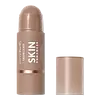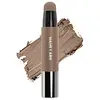Covergirl Trublend Skin Enhancer Balm Contour Stick Versus Haus Labs By Lady Gaga Precision Sculpt Shaping Balm Contour Stick
What's inside
What's inside
 Key Ingredients
Key Ingredients

 Benefits
Benefits

 Concerns
Concerns

 Ingredients Side-by-side
Ingredients Side-by-side

Caprylic/Capric Triglyceride
MaskingIsostearyl Neopentanoate
EmollientMica
Cosmetic ColorantPolyethylene
AbrasiveSynthetic Fluorphlogopite
Simmondsia Chinensis Seed Oil
EmollientKaolin
AbrasiveDicalcium Phosphate
AbrasiveSynthetic Beeswax
Emulsion StabilisingSynthetic Wax
AbrasiveAluminum Hydroxide
EmollientStearalkonium Bentonite
Gel FormingCalcium Sodium Borosilicate
Polyhydroxystearic Acid
EmulsifyingSilica
AbrasivePropylene Carbonate
SolventPentaerythrityl Tetra-Di-T-Butyl Hydroxyhydrocinnamate
AntioxidantPunica Granatum Pericarp Extract
Skin ConditioningTin Oxide
AbrasiveRubus Idaeus Leaf Extract
Skin ConditioningVitis Vinifera Fruit Extract
Skin ConditioningIron Oxides
CI 77891
Cosmetic ColorantCI 42090
Cosmetic ColorantCI 15985
Cosmetic ColorantCI 45410
Cosmetic ColorantCI 15850
Cosmetic ColorantCI 19140
Cosmetic ColorantCaprylic/Capric Triglyceride, Isostearyl Neopentanoate, Mica, Polyethylene, Synthetic Fluorphlogopite, Simmondsia Chinensis Seed Oil, Kaolin, Dicalcium Phosphate, Synthetic Beeswax, Synthetic Wax, Aluminum Hydroxide, Stearalkonium Bentonite, Calcium Sodium Borosilicate, Polyhydroxystearic Acid, Silica, Propylene Carbonate, Pentaerythrityl Tetra-Di-T-Butyl Hydroxyhydrocinnamate, Punica Granatum Pericarp Extract, Tin Oxide, Rubus Idaeus Leaf Extract, Vitis Vinifera Fruit Extract, Iron Oxides, CI 77891, CI 42090, CI 15985, CI 45410, CI 15850, CI 19140
Dimethicone
EmollientSynthetic Wax
AbrasiveSilica
AbrasivePolyglyceryl-2 Triisostearate
EmulsifyingCaprylyl Methicone
Skin ConditioningDiisostearyl Malate
EmollientCaprylic/Capric Triglyceride
MaskingTrimethylsiloxysilicate
EmollientDimethicone/Vinyl Dimethicone Crosspolymer
Skin ConditioningRicinus Communis Seed Oil
MaskingZea Mays Oil
EmulsifyingVitis Vinifera Fruit Extract
Skin ConditioningRosa Hybrid Flower Extract
Skin ConditioningQuercus Suber Bark Extract
Skin ConditioningSqualane
EmollientArnica Montana Flower Extract
MaskingAngelica Gigas Root Extract
Skin ConditioningPseudozyma Epicola/Lithospermum Erythrorhizon Root Extract Ferment Filtrate Extract
EmollientPseudozyma Epicola/Avocado Oil Ferment Extract
EmollientPrunus Armeniaca Kernel Oil
MaskingOlea Europaea Fruit Oil
MaskingPrunus Amygdalus Dulcis Oil
Skin ConditioningHelianthus Annuus Seed Oil
EmollientGlycyrrhiza Glabra Root/Sucrose Ferment Extract Filtrate
AntioxidantPseudozyma Epicola/Camellia Sinensis Seed Oil Ferment Extract Filtrate
HumectantPseudozyma Epicola/Sunflower Seed Oil Ferment Extract Filtrate
Emulsion StabilisingPolyglyceryl-3 Diisostearate
EmulsifyingPolyglyceryl-3 Polyricinoleate
EmulsifyingStearalkonium Bentonite
Gel FormingCalcium Sodium Borosilicate
Triethoxycaprylylsilane
Boron Nitride
AbsorbentKaolin
AbrasiveAluminum Hydroxide
EmollientPentaerythrityl Tetra-Di-T-Butyl Hydroxyhydrocinnamate
AntioxidantDicalcium Phosphate
AbrasiveCetearyl Dimethicone/Vinyl Dimethicone Crosspolymer
EmollientPolyhydroxystearic Acid
EmulsifyingCI 77891
Cosmetic ColorantCI 77491
Cosmetic ColorantCI 77492
Cosmetic ColorantCI 77007
Cosmetic ColorantDimethicone, Synthetic Wax, Silica, Polyglyceryl-2 Triisostearate, Caprylyl Methicone, Diisostearyl Malate, Caprylic/Capric Triglyceride, Trimethylsiloxysilicate, Dimethicone/Vinyl Dimethicone Crosspolymer, Ricinus Communis Seed Oil, Zea Mays Oil, Vitis Vinifera Fruit Extract, Rosa Hybrid Flower Extract, Quercus Suber Bark Extract, Squalane, Arnica Montana Flower Extract, Angelica Gigas Root Extract, Pseudozyma Epicola/Lithospermum Erythrorhizon Root Extract Ferment Filtrate Extract, Pseudozyma Epicola/Avocado Oil Ferment Extract, Prunus Armeniaca Kernel Oil, Olea Europaea Fruit Oil, Prunus Amygdalus Dulcis Oil, Helianthus Annuus Seed Oil, Glycyrrhiza Glabra Root/Sucrose Ferment Extract Filtrate, Pseudozyma Epicola/Camellia Sinensis Seed Oil Ferment Extract Filtrate, Pseudozyma Epicola/Sunflower Seed Oil Ferment Extract Filtrate, Polyglyceryl-3 Diisostearate, Polyglyceryl-3 Polyricinoleate, Stearalkonium Bentonite, Calcium Sodium Borosilicate, Triethoxycaprylylsilane, Boron Nitride, Kaolin, Aluminum Hydroxide, Pentaerythrityl Tetra-Di-T-Butyl Hydroxyhydrocinnamate, Dicalcium Phosphate, Cetearyl Dimethicone/Vinyl Dimethicone Crosspolymer, Polyhydroxystearic Acid, CI 77891, CI 77491, CI 77492, CI 77007
 Reviews
Reviews

Ingredients Explained
These ingredients are found in both products.
Ingredients higher up in an ingredient list are typically present in a larger amount.
Aluminum Hydroxide is a form of aluminum. It can be naturally found in nature as the mineral gibbsite. In cosmetics, Aluminum Hydroxide is used as a colorant, pH adjuster, and absorbent.
As a colorant, Aluminum Hydroxide may add opacity, or reduce the transparency. Aluminum hydroxide is contains both basic and acidic properties.
According to manufacturers, this ingredient is an emollient and humectant. This means it helps hydrate the skin.
In medicine, this ingredient is used to help relieve heartburn and help heal ulcers.
There is currently no credible scientific evidence linking aluminum hydroxide in cosmetics to increased cancer risk.
Major health organizations allow the use of aluminum hydroxide in personal care products and have not flagged it as a carcinogenic risk at typical usage levels.
Learn more about Aluminum HydroxideCalcium Sodium Borosilicate is a bulking agent. It is considered a borosilicate glass; it is composed of powder or flakes of calcium and sodium borosilicates.
This ingredient is used to add volume, shine, and color to products. You'll most likely find this ingredient in makeup products.
According to in-vivo and ex-vivo studies done by a manufacturer, this ingredient works well with UV filters:
Learn more about Calcium Sodium BorosilicateThis ingredient is an emollient, solvent, and texture enhancer. It is considered a skin-softener by helping the skin prevent moisture loss.
It helps thicken a product's formula and makes it easier to spread by dissolving clumping compounds.
Caprylic Triglyceride is made by combining glycerin with coconut oil, forming a clear liquid.
While there is an assumption Caprylic Triglyceride can clog pores due to it being derived from coconut oil, there is no research supporting this.
Learn more about Caprylic/Capric TriglycerideCi 77891 is a white pigment from Titanium dioxide. It is naturally found in minerals such as rutile and ilmenite.
It's main function is to add a white color to cosmetics. It can also be mixed with other colors to create different shades.
Ci 77891 is commonly found in sunscreens due to its ability to block UV rays.
Learn more about CI 77891Dicalcium Phosphate is an exfoliant.
Kaolin is a clay. It is used for oil control and to help minimize pores. Like other clays, kaolin has the ability to absorb excess sebum or oil. This can help clean out pores and mattify the skin.
Some types of kaolin may have exfoliating properties. When water is added to kaolin, it becomes a paste with small abrasive particles.
Most kaolin is a white color, but may be pink/orange/red depending on where it comes from.
The name 'kaolin' comes from a Chinese village named 'Gaoling'. Kaolin clay comes from rocks rich in kaolinite. Kaolinite, the mineral, has a silicate layered structure. Kaolinite is formed from chemical weathering of aluminum siilicate minerals.
Besides skincare, kaolin is commonly used to make glossy paper, in ceramics, toothpaste, and as medicine to soothe stomach issues.
Learn more about KaolinPentaerythrityl Tetra-Di-T-Butyl Hydroxyhydrocinnamate (long name, huh?) is a synthetic antioxidant.
It is used to help stabilize other antioxidants or prevent the color from changing in a product.
As an antioxidant, it helps fight free-radical molecules. Free-radical molecules are capable of damaging our cells and other genetic material. Thus, antioxidants may reduce the signs of aging.
This ingredient is oil-soluble.
Learn more about Pentaerythrityl Tetra-Di-T-Butyl HydroxyhydrocinnamatePolyhydroxystearic Acid is a soft wax made from castor oil.
It is is a texture thickener, emulsifier, and film-former. Emulsifiers prevent ingredients from separating, such as oils and waters.
Polyhydroxystearic Acid may not be fungal acne safe.
Learn more about Polyhydroxystearic AcidSilica, also known as silicon dioxide, is a naturally occurring mineral. It is used as a fine, spherical, and porous powder in cosmetics.
Though it has exfoliant properties, the function of silica varies depending on the product.
The unique structure of silica enhances the spreadability and adds smoothness, making it a great texture enhancer.
It is also used as an active carrier, emulsifier, and mattifier due to its ability to absorb excess oil.
In some products, tiny microneedles called spicules are made from silica or hydrolyzed sponge. When you rub them in, they lightly polish away dead skin layers and enhance the penetration of active ingredients.
Learn more about SilicaWe don't have a description for Stearalkonium Bentonite yet.
Synthetic Wax is created from fossil fuels such as natural gas. It is used to enhance texture, adjust pH, and as an occlusive.
It may also be used as an abrasive ingredient to exfoliate the skin.
Synthetic Wax may not be fungal acne safe.
Learn more about Synthetic WaxVitis Vinifera Fruit Extract comes from grapes.
Grape extract has many skin benefits. It also contains many potent antioxidants such as Vitamin E , Vitamin C, proanthocyanidins, polyphenols, flavonoids, and anthocyanins. Antioxidants help protect skin. Proanthocyanidin have also been shown to help even out skin tone.
Grape extract also helps soothe and hydrate your skin.
Learn more about Vitis Vinifera Fruit Extract